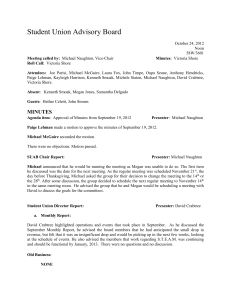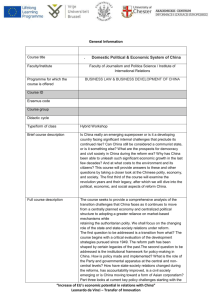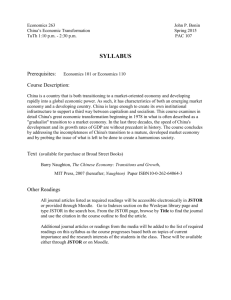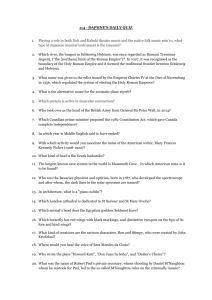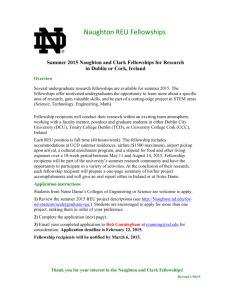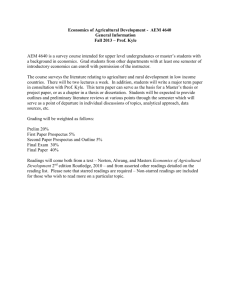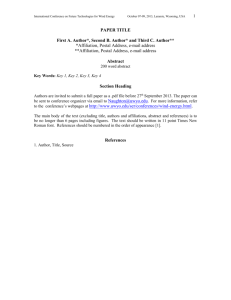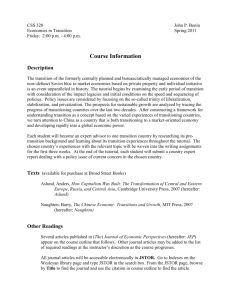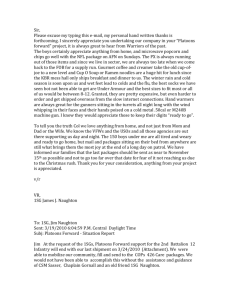Syllabus - WesFiles
advertisement
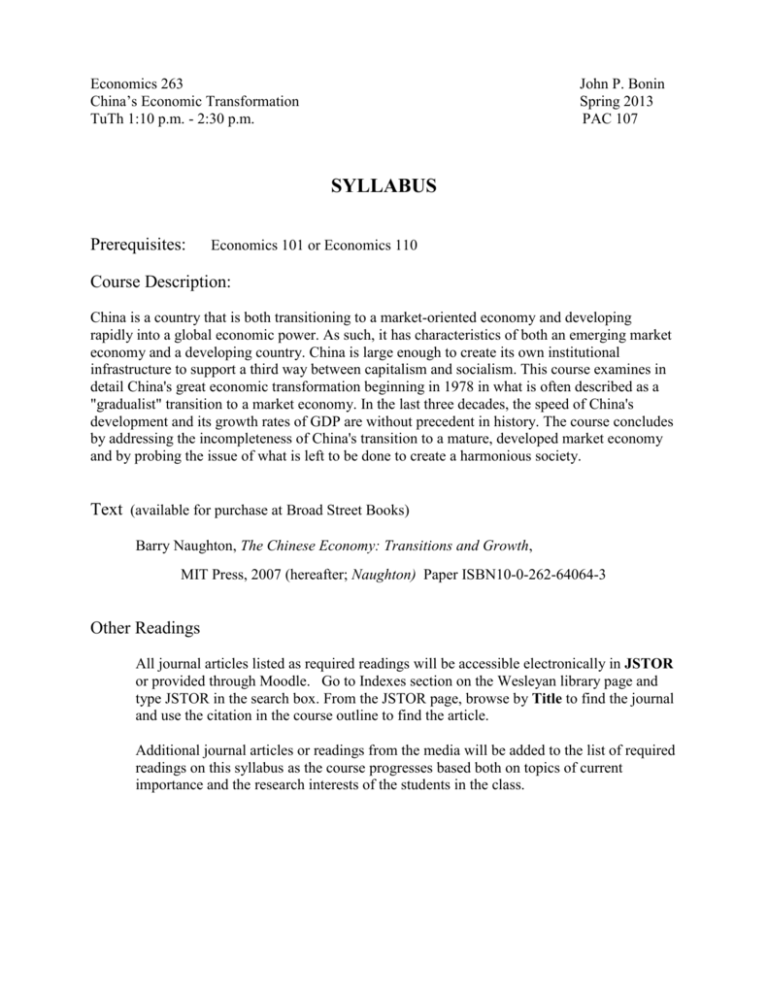
Economics 263 China’s Economic Transformation TuTh 1:10 p.m. - 2:30 p.m. John P. Bonin Spring 2013 PAC 107 SYLLABUS Prerequisites: Economics 101 or Economics 110 Course Description: China is a country that is both transitioning to a market-oriented economy and developing rapidly into a global economic power. As such, it has characteristics of both an emerging market economy and a developing country. China is large enough to create its own institutional infrastructure to support a third way between capitalism and socialism. This course examines in detail China's great economic transformation beginning in 1978 in what is often described as a "gradualist" transition to a market economy. In the last three decades, the speed of China's development and its growth rates of GDP are without precedent in history. The course concludes by addressing the incompleteness of China's transition to a mature, developed market economy and by probing the issue of what is left to be done to create a harmonious society. Text (available for purchase at Broad Street Books) Barry Naughton, The Chinese Economy: Transitions and Growth, MIT Press, 2007 (hereafter; Naughton) Paper ISBN10-0-262-64064-3 Other Readings All journal articles listed as required readings will be accessible electronically in JSTOR or provided through Moodle. Go to Indexes section on the Wesleyan library page and type JSTOR in the search box. From the JSTOR page, browse by Title to find the journal and use the citation in the course outline to find the article. Additional journal articles or readings from the media will be added to the list of required readings on this syllabus as the course progresses based both on topics of current importance and the research interests of the students in the class. 2 Economics 263 COURSE NOTES Readings Students are expected to complete the reading assignments announced at each class meeting before the next class to facilitate informed classroom discussion and to insure a regular work pace. The instructor will follow the course outline in assigning readings. Assignments Three Writing Assignments: One for Each Module Writing should not be left to the last minute. By writing, we find out what we do not know and, hence, what we need to learn. In essence, writing should be an equal partner with reading in the learning process. The successful student recognizes this quickly and begins writing while reading the material on the topic. By revising what we have written, we tighten and improve the argument. Papers that have not been revised at least once do not present the writer’s best work. Our teaching apprentice is available to help with revisions. Research Project with Timetable Each student will pursue a topic of interest regarding the incompleteness of China’s transition to a mature, developed market economy and a harmonious society. A précis of work in progress is due after the spring break. The final research paper is due at the end of the term. Some class time toward the end of the term will be devoted to group presentations based on the students’ research projects. Identification of Topic: February 28 Précis of Work in Progress: April 4 Final Research Paper: May 17 Class Rules Penalties and Rewards Equity dictates that any late work is subject to a grade penalty, namely one full grade per week. In addition, any student who attends class infrequently may be assessed a grade penalty for poor class participation. Extra credit may be given for exceptional class participation, especially during the group presentations and class discussions of the research topics. 3 Economics 263 Incompletes An incomplete will be granted only for extreme hardship. If granted, an incomplete is subject to a modified grade penalty. University policy requires that all incomplete work must be completed by the first day of the subsequent semester. When granting an incomplete, this instructor calculates a provisional grade assuming that the work to be completed is evaluated at zero. Consequently, the provisional grade submitted with the incomplete is usually F. This grade becomes a permanent fixture on the transcript of any student who does not complete the work by the prescribed date. The instructor will enforce the university requirements regarding incompletes. Please do not take unnecessary risk; avoid incompletes! Schedule of Writing Assignments and Grade Percentages Assignment #1 February 21 (25%) Assignment #2 March 7 (25%) Précis of Work in Progress April 4 Assignment #3 April 25 (15%) Final Research Paper (& Presentation) May 17 (35%) Other Information Instructor Office Hours: PAC 305 Tuesday: 2:40 p.m. – 4:00 p.m. Wednesday: 2:00 p.m. – 4:00 p.m. Other Times: Possible by Arrangement Contact Information: jbonin@wesleyan.edu or x2353 Teaching Apprentice: Anike Arni 4 Economics 263 COURSE OUTLINE Module 1: Transition or Development or Hybrid? A: Overview and Legacies (Jan. 24 – Jan. 29) Naughton: Introduction & Chapters 1, 2 & 3 B. Transition to the Market (Jan. 31 – Feb. 7) Naughton: Chapters 4 & 5 C. Growth and Structural Change (Feb. 7 – Feb. 21) Naughton: Chapters 6, 7, 8, 9, 10 & 11 Writing Assignment#1: China’s Transformation Strategy Beginning in 1978, China began to reform its economy. In the subsequent three plus decades, the speed of China’s development and its growth rates in GDP per capita are without precedent in history. Naughton divides the thirty-year period into two phases of reform. Using the information in the readings only, identify the development aspects of the early (first phase) reform period in China. Identify the main engines (factors) of China’s rapid growth in both phases and trace carefully their impact on overall growth. To conclude this section, relate the legacies from the first phase of reforms to subsequent reform policies undertaken and the resulting growth outcomes in the second phase. To focus on the transitioning aspects of the Chinese growth story, Naughton characterizes the thirty-year period of economic reform beginning in 1978 as “growing out of the plan.” Using information from the readings, discuss the changing composition of plan and market ingredients during this thirty-year period to support Naughton’s point. Focusing on the countryside and the agricultural sector, discuss the transitioning-to-the-market aspects of rural reforms. Conclude your paper by evaluating briefly the transformation road taken by China in terms of both its successes and any resulting (remaining) distortions. Expected Length: No more than seven (7) but at least five (5) double-spaced typewritten pages in standard font of normal size, e.g., this assignment is typed in Times New Roman, size 12, with standard page margins. Due Date: February 21 5 Economics 263 Module 2: Gradualism or Procrastination? A. Rural Industrialization: Organizational Reform (Feb. 21 - Feb. 26) Naughton: Chapter 12 B. Industrial Change: Toward a Modern Economy (Feb. 26 - March 7) Naughton: Chapters 13, 14 & 15 Perkins, Dwight, “Completing China’s Move to the Market,” Journal of Economic Perspectives (hereafter, JEP), 8:2, (Spring) 1994, pp. 23 - 46. Jefferson, Gary and Rawski, Thomas, “Enterprise Reform in Chinese Industry,” JEP, 8:2, (Spring) 1994, pp. 47 - 70. Yusuf, Shahid, “China’s Macroeconomic Performance and Management During Transition,” JEP, 8:2, (Spring) 1994, pp. 71 - 92. Writing Assignment#2: China’s Modernization and Industrialization In dividing the thirty years of reform in China into two phases, Naughton characterizes the first phase as “reforms without losers” and the second phase as “reforms with losers.” Would Perkins and Yusuf agree with Naughton’s assessment of the first phase? Justify your opinion by using information from each of their assessments of the early reform period. Evaluate Naughton’s assessment of the second phase by considering both rural and urban sectors. Rawski and Jefferson conclude their analysis of the first phase of enterprise reforms in China with an optimistic statement concerning China’s ability to harness its potential for further gains without creating intolerable political tensions or social costs. What changes were not anticipated by Rawski and Jefferson that support Naughton’s more pessimistic characterization of the second phase as “reforms with losers.”? To probe further Naughton’s distinction between the two phases, relate the outcomes from policies undertaken in the first phase to subsequent enterprise reform policies introduced in the second phase. Establish the sense in which the second phase of enterprise reforms leaves incomplete China’s transition to a mature, developed market economy. In the introduction, Naughton claims that China’s current diversity can be traced to two incomplete transitions. Conclude your paper by discussing the sense in which the second phase of enterprise reforms leaves incomplete China’s transition to a mature, developed market economy. Expected Length: No more than seven (7) but at least five (5) double-spaced typewritten pages in standard font of normal size, e.g., this assignment is typed in Times New Roman, size 12, with standard page margins Due Date: March 7 6 Economics 263 Précis of Work in Progress Due Date: April 4 A research prospectus and précis of work in progress contains three essential components. 1. The motivation for the research and a statement of the research question. A clear statement of the focus of your research with a specification of the research question should be provided. 2. A statement of the research approach to be taken and the progress made should be provided. The following questions may provide useful prompts for presenting and developing the research approach. However, they are not intended to be a list of exam questions to be answered individually. Please use judiciously! How do you intend to answer the research question? What evidence will you seek? What supportive argumentation will you use? What are your anticipated results? How do you expect to support any resulting policy conclusions? In addition, a brief statement of the work you have accomplished to date should be included. This statement should identify any difficulties that you foresee in dealing with your research question so that the instructor can provide help in a timely manner. 3. An annotated bibliography. This consists of a list of sources that you have found to date for your research project. Each citation is accompanied by two or three sentences that link the material in the source directly to your research question. You must explain why you think that this source will be useful in dealing with your research question. The references should be arranged alphabetically by the author’s last name. Be sure to include full information in your citations. See the references at the end of the chapters in Naughton for examples of proper formats for citations. Expected Length: Sections 1 and 2 combined should be at least three (3) but no more than five (5) pages. Section 3 should be at least two (2) but no more than three (3) pages. 7 Economics 263 Module 3: China Becoming a Global Economic Power? (March 26 – April 25) Naughton: Chapters 16, 17, 18, 19 & 20 - To be completed with additional readings – Writing Assignment #3 China’s Opening Up With Sustainable Growth? (Preliminary) Provide an overview of the emergence of China as a global economic powerhouse. Include the roles played by international trade, international finance, and domestic finances. Discuss fully the interrelationships among the important macroeconomic relationships. Be sure to include any relevant data from Naughton and other assigned readings. Returning to Naughton’s statement about incomplete transitions, identify the major aspects of the Chinese economy that continue to impede the completion of its transition to a mature, developed market economy. Conclude your essay with a brief assessment of whether China’s current transition path is leading the country toward a harmonious society, which is the overarching policy goal adopted by the Chinese Communist Party at its Sixth Plenum meeting. Does a harmonious society differ from a mature, developed market economy? How would you define a harmonious society? Given your definition, what is left to be done for China to achieve its stated goal? Expected Length: No more than five (5) but at least three (3) double-spaced typewritten pages in standard font of normal size, e.g., this assignment is typed in Times New Roman, size 12, with standard page margins. Due Date: April 25 Group Presentations and Discussions (April 30 – May7) Tuesday, April 30: Unfinished Reform: Towards a New Growth Model Huang: China’s Great Ascendancy Discussion Briefs on Moodle Thursday, May 2: Environmental Degradation and Inequality Naughton: Ch. 20 Discussion Briefs on Moodle Tuesday, May 7: Wrap-up (Discussion Briefs on Moodle) Growth and Rebalancing Outward FDI Labor Market and Population 8 Economics 263 WRITING TIPS 1. Every paper should have an integrative theme in the introductory paragraph. The integrative theme specifies the position that will be taken and defended; hence, it serves as a selection tool to guide the writer in determining what to include in the final version of the paper. Write no paper without an integrative theme. 2. The easiest way to develop a strong argument is to force differences. Sometimes this can be done effectively in a point-counterpoint framework. Evidence and well-structured logical arguments are the foundations of good analytical writing. Make sure that your paper deals with the topic in sufficient depth. 3. Each paragraph must have its own integrity and be brought to closure. A paragraph is NOT a laundry list of assertions. Nor should a point-counterpoint development be left unresolved to drift into oblivion. You should be able to state the basic point of each paragraph using a four-word phrase. Each paragraph must bring the point to closure. CONCLUDE a paragraph; don’t simply end it. 4. A paper is like an hourglass. The introduction begins from a broad perspective to motivate the paper and narrows by stating the integrative theme. The body of the paper develops fully and solidly the position in the integrative theme. Paragraphs make individual points; they are arranged sequentially to support and defend as strongly as possible the position taken. The conclusion does not simply restate the position or recapitulate what has been done. Rather the conclusion should convince the reader that the writer has supported the position compellingly. Convince the reader of the strength of your analysis in the conclusion. FROST YOUR CAKE!
